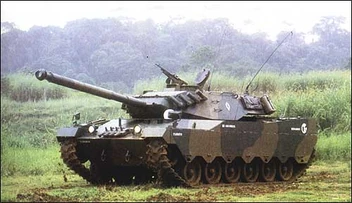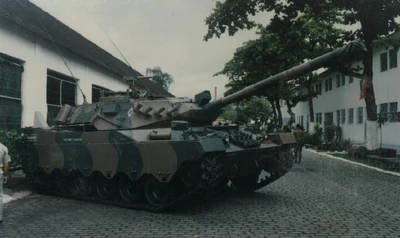The Tamoyo is a Brazilian battle tank, Developed by Bernardini in partnership with Technological Center of the Army based on experience gained with the modernization of M41C Caxias. It was never produced in series
Description[]

Bernardini MB-3 Tamoyo
The Tamoyo is a derivative of M41, incorporating new technologies and a cannon 90 or 105 mm, while maintaining the features considered by Brazilian Army in M41. Prototypes were developed in various parts based on parts of the M-41, the train rolling and suspension were similar.
Unlike EE-T1 Osorio of Engesa, the Tamoyo was a medium tank, and designed according to the needs of the Brazilian Army and the national car park in order to reduce dependence on imported equipment and parts. The Osorio was an MBT, a heavy battle tank was developed for a possible order of Saudi Arabia, And incorporated several imported equipment.
Based on the operational requirements established by the Brazilian Army, the Bernardini began developing the new vehicle, originally called X-30. The vehicle could not overcome the 30 tonnes limit imposed by road and rail system in Brazil. National companies that were contacted could supply components for the project.
Prototypes[]
The first prototype was completed in 1984 and was designated I Tamoyo. It had suspension by torsion bars, 90mm cannon, engine Scania DSI 14, rotating mechanism of the tower national transmission CD-500-3 (the same used in the M-41) and low silhouette.
The Tamoyo II aimed to adapt the vehicle to the international market, incorporating more sophisticated imported equipment, among others optronics and a new transmission.
The Tamoyo III presented a series of improvements, is easily distinguished from previous models. The Tamoyo is incorporating modern technologies such as armor composed of steel and ceramics, laser rangefinder, night vision and thermal scan direction of fire tower stabilized for firing on the move. The vehicle received the modern cannon of 105mm Royal Ordnance L7 and a V8 Detroit diesel series 92. The chassis was modified and the tower and the frontal armor was increased, the total weight reached 31 tons
Nationalization[]
W

Tamoyo III
if options for a 90mm or 105mm cannon manufacturer claimed that the tank could be used both as a medium armored vehicle recognition, as with the larger 105mm cannon and armor and better engine could form groups of tanks, suitable for confront any threat that could be expected in the South American continent.
The Tamoyo could be equipped with a computer shot FERRANTI While the periscope was American, manufactured by the company Kolmorgan. Some of the systems were not installed on board tanks TAM Argentines were at the height reference for the Brazilians.
The engine considered for the tank was initially set DA14 Scania engine with power increased to 736cv manufactured by Scania in Brazil. But the possibility of using a motor-GM8V92TA Detroit Diesel was also considered in case the vehicle is exported and there preference for that engine.
The great advantage of Tamoyo as a possibility for Brazilian battle tank, was in the large percentage of incorporating components manufactured in Brazil. All armor, tower systems Hydraulic, caterpillars, one of the engines and even the cannon (for the 90mm) can be manufactured in Brazil. Some of the other equipment, although international in origin, could be nationalized since the number of systems to acquire and would be sufficient to justify the operation.
Specifications[]
General Characteristics[]
- Crew: 4
- Length: 8.77M
- Width: 3.22M
- Height: 2.2M
- Empty Weight: 28.000 kg
- Embattled Weight: 30.000 kg
Performance[]
- Traction System: Caterpillars
- Engine: GM 8V92TA Detroit-Diesel
- Power: 750 hp
- Maximum Speed: 70 km/h
- Speed Over Rough Terrain: 30 km/h
- Fuel Tank: 700 Liters
Armament[]
- Main Gun: Royal Ordnance L7
- Secondary Guns: 1x M2 Browning, 1 coaxial 7.62 MG and 8 smoke grenade launchers.
See also[]
- EE-T1 Osorio
- M41C Caxias
- Leopard 1
References[]
External links[]
The original article can be found at Bernardini MB-3 Tamoyo and the edit history here.